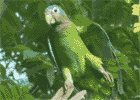Forest structure
Cockpit Country forests include tall, closed-canopy forest
formations with relatively sparse understorey in the cockpit
bottoms, where terra rossa soils are often deep, and
seasonal flooding may occur; and the shorter and denser woodlands
of the steeply sloping sides and exposed tops of the rocky hills,
where the soil is either a humus mat, secured by roots, or pockets
of terra rossa in crannies in the rock. Rapid drainage
creates drought-like conditions. Analysis of the effects of aspect,
slope and drainage on biodiversity is likely to lead to
identification of further sub-types (Proctor 1986).
Asprey and Robbins (1953) described the bottoms as a Terminalia-Cedrela association and listed 46 common trees. Common timber species include Breadnut (Brosimum alicastrum), Black Lancewood (Oxandra lanceolata) and Timber Sweetwood (Nectandra sanguinea). Silk Cotton (Ceiba pentandra) is an occasional emergent. Figs (Ficus spp.) are common in some areas. In the undisturbed bottoms the canopy is 30-35 m high with occasional emergents reaching 45m (Eyre 1989). Ferns are abundant and about one hundred species of ferns, including many Jamaican endemics, have been described from the Cockpit Country but only one is a Cockpit Country endemic (Proctor 1986).
Although the largest trees are found in the bottoms, the rare and unique species tend to be found on the steep inaccessible hillsides (G.R. Proctor pers. comm.). They include many species of orchids, vines and shrubs, as well as trees and cacti.
Plant species composition
Information on the plant species composition and distribution of
the Cockpit Country is incomplete and many years of concentrated
work will be needed to begin to approach a comprehensive evaluation
of the flora. At present, 106 species of vascular plants from 43
families have been found only in the Cockpit Country. This includes
101 Cockpit Country endemics. The remaining five species are not
endemic, but in Jamaica occur only in the Cockpit Country.
The list of known Cockpit Country endemic plants includes 6 species of Lepanthes orchids; 4 species of bromeliads; and 2 species of wild yam. In addition there are 12 herbs, 4 herbaceous vines, 2 sub-woody vine, 4 woody scramblers, 39 shrubs, 15 shrubs or small trees and 15 trees species. Many of these have potential value for horticulture, forestry, crafts or medicines.
Many plants show distinctive adaptations for survival in a karst environment, which is noted for shallow soils, deleteriously high concentrations of calcium and magnesium, and the free-draining nature of limestone that restricts access to water resources (see Vermeulen and Whitten 1999). Adaptations for the drought-like conditions of hilltops include waxy leaves to prevent dessication (e.g., Clusia spp.) and extensive root systems to penetrate cracks in the limestone to access deeper water sources (e.g., Ficus spp.) On summit plateaus, leaf litter accumulates over the limestone to form a layer of acid peat that isolates the plants growing on it from the alkaline bedrock. Species adapted to these acidic conditions frequently are isolated to the peaks due to the inhospitable alkaline bedrock of the slopes. Species highly adapted to talus slopes will find both the hilltops and sinks, with their accumulated humus, as impassible as terrestrial organisms find an ocean surrounding their island landmass.
Patterns of endemism
The progressive and irregular isolation of hillocks over geological
time in the process of karstification typically results in high
biological diversity. This is demonstrated clearly in the Cockpit
Country (Proctor, 1986). In the Cockpit Country, as in other parts
of Jamaica, and the tropics (Brown, 1999), high endemism of plants
and other flightless organisms is often associated with geological
discontinuities and sometimes forest edges. In particular, many
endemics are found where the Central Inlier meets tertiary
limestones, (for example near Albert Town, Troy, Spring Garden and
White Rock Hill), or where there are extensive alluvial areas
adjacent to limestone (for example near Barbecue Bottom and
Windsor). The varied topography of karst terrain, include intricate
patterns of substrates and degrees of exposure, creates a wide
variety of microhabitats and, consequently, a wide variety of
species adapted to specific niches (Vermuelen and Whitten 1999)
Preliminary analysis suggests that Cockpit Country endemic plants are not trees, but shrubs, epiphytes and vines, which are dependent on the presence of tree species for survival. They are often found on slopes and hill tops and are not restricted to the undisturbed forests but also persist along road edges (e.g. Burnt Hill road) and on isolated hills on the periphery (see above).
All undisturbed hills should be regarded as potential islands of endemism.
Rare or relict community types
Ecological conditions, deforestation, microclimate change and loss
or reduction of keystone species, mean that some plant communities
have become restricted in area. The two rarest community types
known to survive in the Cockpit Country are the Podocarpus
purdianus forest (a few relict trees are located near Troy,
extant in 1992, reassessment is critical; these living relics are
part of the gymnosperm lineage from which flowering plants split
more than 290 million years ago [Qui 1999]) and the tall forests of
the bottom lands. Much more study of community types is needed.
Threatened endangered and rare species
The majority of the 101 Cockpit Country endemic plants are known
from single localities or have been collected only a few times. All
should be considered threatened or rare.
Areas of special genetic importance
Each and every rocky hillock is of potentially of particular
interest from a botanical point of view because of the large number
of national and local endemic species supported. Many species are
known from single hillocks. A survey showed that adjacent hills had
only 80% of their species in common and that the remaining 20%
often included one or more local endemic species (Proctor 1991). It
has been estimated that there are about 10 cockpits per square
kilometer (Eyre 1989). Thus in the total area there are probably
more than 5000 cockpits. Fewer than 50 of these have been examined
in detail by botanists.
The isolated hills on the periphery of the Cockpit Country appear to be richer in endemic species than those in the center, perhaps because they are acting as refugia for species from the surrounding areas of more accessible agricultural lands, which have been deforested. Alternatively, this observed pattern may merely be an artifact of the distribution of botanists. Regardless, these hills present a special problem for the conservation of the area because these areas are more likely to be privately owned, or occupied by squatters and are more accessible and therefore more threatened.


